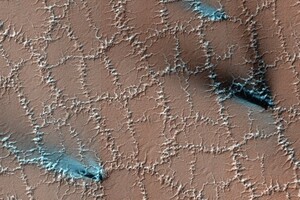Unusual structures formed ice and carbon dioxide.

Scientists were able to explain where the mysterious structures on Mars, which from orbit resemble a honeycomb or a cobweb. In fact, they are formed by the process of seasonal changes in carbon dioxide and water, according to the Science alert. when it arrived in Mars orbit.
Read also: Mars rover Perseverance found a piece of thermal blanket on the Red Planet
The HiRISE team said that solid water and dry ice carbon dioxide play an important role in the formation of these structures. Water ice, which solidifies in the soil, splits the earth into polygons. Dry ice, sublimated from below the surface when the earth warms up in the spring, causes even more erosion, creating channels around the boundaries of such “landfills”.
Polygons form over many years as surface ice compresses and expands as the season approaches. But some regions with polygons show even greater seasonal activity, as indicated by the blue fan-shaped details. According to scientists, in the layer of translucent dry ice that covers the surface, it forms ventilation holes that allow gas to escape.
“The gas removes small particles of material from the surface, which further destroys the channels. Particles fall to the surface in the form of dark fan-shaped deposits. Sometimes dark particles plunge into dry ice, leaving bright traces where the fans were originally located. Often the vent closes and then reopens, so we see two or more fans coming from the same place, but oriented in different directions when the wind changes, “- said HiRISE scientists.
Researchers pay special attention landfill regions of Mars, as they can help them understand the recent activity of the planet and the distribution of ice beneath the surface, as well as give an idea of the climatic conditions of the Red Planet.
Mars is not the only place where such structures occur. Polygons can be found in the Arctic and Antarctic regions of the Earth. The New Horizons spacecraft, which flew past Pluto in 2015, also noticed their existence on this dwarf planet.
Earlier, amateur astronomers looking for signs of extraterrestrial life on Mars noticed an unusual detail in the images he took. Curiosity. The geological structure on them is similar to the “door to the underground temple”.




